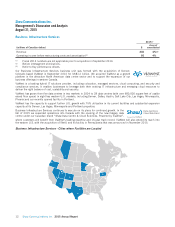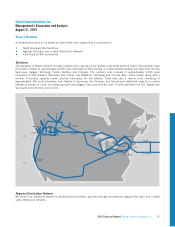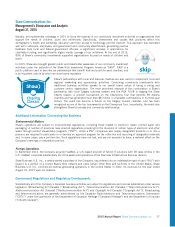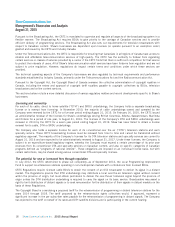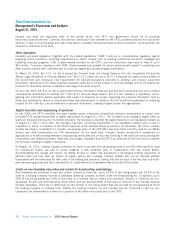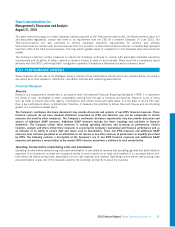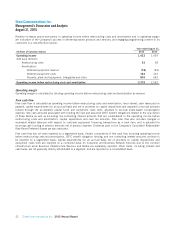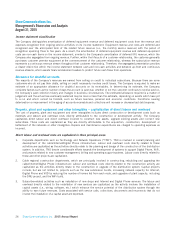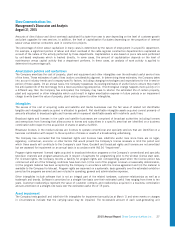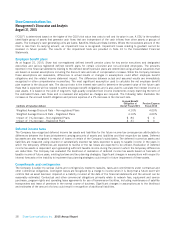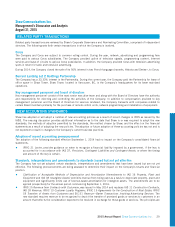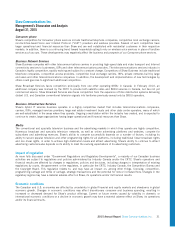Shaw 2015 Annual Report Download - page 23
Download and view the complete annual report
Please find page 23 of the 2015 Shaw annual report below. You can navigate through the pages in the report by either clicking on the pages listed below, or by using the keyword search tool below to find specific information within the annual report.
Shaw Communications Inc.
Management’s Discussion and Analysis
August 31, 2015
The same restrictions apply to certain Canadian carriers pursuant to the Telecommunications Act, the Radiocommunication Act
and associated regulations, except that there is no requirement that the CEO be a resident Canadian. In June 2012, the
Telecommunications Act was amended to remove Canadian ownership requirements for wireline and wireless
telecommunications carriers with annual revenues from the provision of telecommunications services in Canada that represent
less than 10% of the total annual revenues. This may lead to greater levels of competition in the Canadian telecommunications
market.
The Company’s Articles contain measures to ensure the Company continues to comply with applicable Canadian ownership
requirements and its ability to obtain, amend or renew a license to carry on any business. Shaw must file a compliance report
annually with the CRTC confirming that it is eligible to operate in Canada as a telecommunications common carrier.
KEY PERFORMANCE DRIVERS
Shaw measures the success of its strategies using a number of key performance drivers which are outlined below, including a
discussion as to their relevance, definitions, calculation methods and underlying assumptions.
Financial Measures
Revenue
Revenue is a measurement determined in accordance with International Financial Reporting Standards (“IFRS”). It represents
the inflow of cash, receivables or other consideration arising from the sale of products and services. Revenue is net of items
such as trade or volume discounts, agency commissions and certain excise and sales taxes. It is the base on which free cash
flow, a key performance driver, is determined; therefore, it measures the potential to deliver free cash flow as well as indicating
growth in a competitive market place.
The Company’s continuous disclosure documents may provide discussion and analysis of non-IFRS financial measures. These
financial measures do not have standard definitions prescribed by IFRS and therefore may not be comparable to similar
measures disclosed by other companies. The Company’s continuous disclosure requirements may also provide discussion and
analysis of additional GAAP measures. Additional GAAP measures include line items, headings and sub-totals in financial
statements. The Company utilizes these measures in making operating decisions and assessing its performance. Certain
investors, analysts and others utilize these measures in assessing the Company’s operational and financial performance and as
an indicator of its ability to service debt and return cash to shareholders. These non-IFRS measures and additional GAAP
measures have not been presented as an alternative to net income or any other measure of performance or liquidity prescribed
by IFRS. The following contains a description of the Company’s use of non-IFRS financial measures and additional GAAP
measures and provides a reconciliation to the nearest IFRS measure or provides a reference to such reconciliation.
Operating income before restructuring costs and amortization
Operating income before restructuring costs and amortization is calculated as revenue less operating, general and administrative
expenses. It is intended to indicate the Company’s ability to service and/or incur debt, and therefore it is calculated before one-
time items like restructuring costs, amortization (a non-cash expense) and interest. Operating income before restructuring costs
and amortization is also one of the measures used by the investing community to value the business.
2015 Annual Report Shaw Communications Inc. 21



